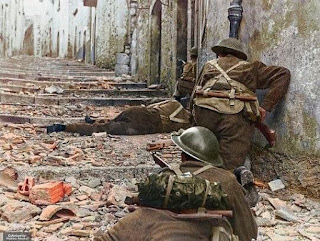The Meat Grinder of Ortona: The Italian Stalingrad
- Get link
- X
- Other Apps
In December 1943, the Canadian 1st Division faced one of its most grueling and fierce battles during World War II in the ancient coastal city of Ortona. This brutal conflict, often referred to as the "Italian Stalingrad," pitted the determined Canadian troops against the resolute German defenders in a deadly urban warfare scenario. The battle for Ortona, characterized by its intensity and high casualties, became a testament to the resilience and bravery of the Canadian forces and the strategic significance of the Italian campaign.
The Strategic Importance of Ortona
Ortona, a small yet strategically vital city on the Adriatic coast of Italy, was critical to the Allied advance towards Rome. Capturing Ortona would allow the Allies to secure a key port and facilitate the movement of supplies and reinforcements. For the Germans, holding Ortona was essential to delaying the Allied advance and maintaining their defensive line across central Italy.
The terrain surrounding Ortona, with its narrow streets and ancient buildings, presented significant challenges for the attacking forces. The Germans, under the command of Generalleutnant Richard Heidrich of the 1st Parachute Division, had fortified the city extensively, preparing for a staunch defense that would turn Ortona into a veritable fortress.
The Canadian Assault
The battle for Ortona began in earnest on December 20, 1943, as the Canadian 1st Division, led by Major-General Chris Vokes, launched their assault on the city. The Canadians faced fierce resistance from the well-entrenched German paratroopers, who had transformed every building into a potential stronghold and laid numerous traps throughout the city.
The fighting quickly devolved into intense, close-quarters combat. The Canadians, advancing through the narrow, rubble-strewn streets, had to clear buildings room by room, often using bayonets and hand grenades. This brutal method of warfare led to the nickname "The Meat Grinder," as both sides suffered heavy casualties in the relentless struggle for control of the city.
Urban Warfare and Tactical Innovation
The Canadian troops demonstrated remarkable adaptability and ingenuity in overcoming the German defenses. One of the notable tactics employed was "mouse-holing," where soldiers blasted holes through the walls of adjoining buildings to move forward while minimizing exposure to enemy fire in the streets. This method allowed them to advance through the city more effectively, bypassing heavily defended positions and reducing their vulnerability to sniper and machine-gun fire.
Despite these innovations, the Canadians faced an arduous and slow advance. The battle's intensity and the urban environment's complexity made every inch of progress costly. The soldiers endured constant danger from booby traps, mines, and well-concealed enemy positions. The harsh winter conditions further compounded their difficulties, with cold and rain adding to the misery of the combatants.
The Aftermath and Legacy
After eight days of relentless fighting, the Canadians finally succeeded in capturing Ortona on December 28, 1943. The victory, though hard-won, came at a high price. The Canadian 1st Division suffered significant casualties, with many soldiers paying the ultimate sacrifice in the battle's bloody grind. The German defenders, although eventually forced to withdraw, had inflicted severe losses on the advancing forces and delayed the Allied push towards Rome.
The Battle of Ortona stands as a poignant chapter in the history of the Italian campaign. It exemplifies the brutal nature of urban warfare and the extraordinary courage and determination of the soldiers who fought there. The Canadians' success in Ortona demonstrated their tenacity and tactical acumen, earning them a place of honor in the annals of military history.
The legacy of Ortona, often dubbed the "Italian Stalingrad," serves as a reminder of the tremendous human cost of war and the resilience of those who fight for freedom. The sacrifices made by the Canadian 1st Division in the "Meat Grinder" of Ortona highlight the profound challenges and heroism that define the story of World War II.
- Get link
- X
- Other Apps

Comments
Post a Comment